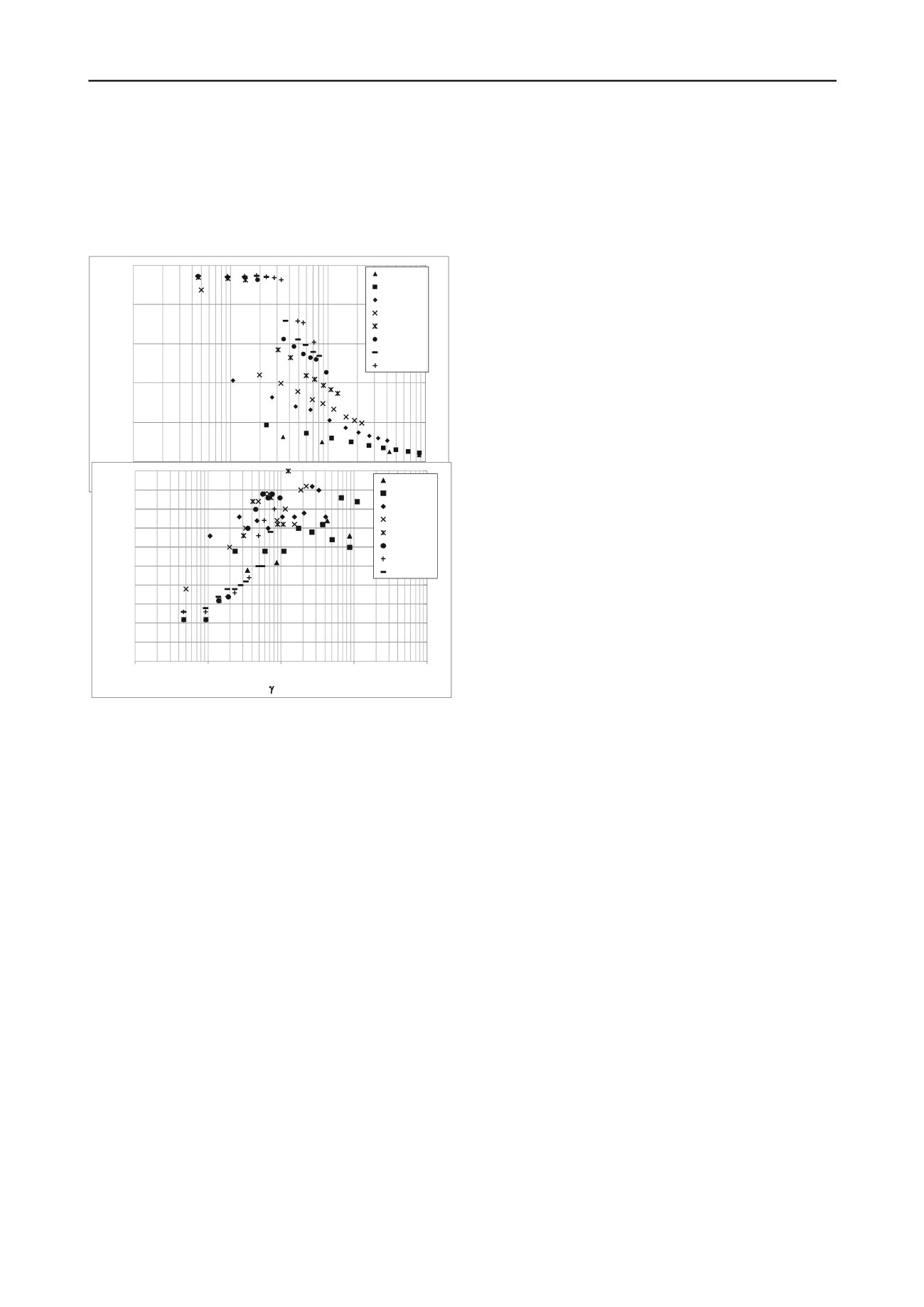
1590
Proceedings of the 18
th
International Conference on Soil Mechanics and Geotechnical Engineering, Paris 2013
Figure 6 illustrates the variation of shear damping ratio (D
T
)
with shearing strain amplitude (
) for Warsaw natural cohesive
soil under various mean effective stress (p’). It is a clear
increase of shear damping ratio with increasing shearing strain
amplitude. Quite significant scatter in the data might have been
caused by the impact of the factors mentioned in the
introduction of this paper.
Difference in the value of shear modulus and damping ratio
is closely related to the test conditions, that is to the mean
effective stress. The more important effect of p’ occurs in G
0
at
small strain amplitude. At higher amplitudes, the variations of G
are not so important.
Although quite a lot of work was performed to investigate
the dynamic properties of natural cohesive soil from Warsaw
area, some more tests are necessary to be carried out in the
future.
5.
6.
7.
8.
9.
Figure 5. Variation of shear modulus with shearing strain amplitude for
Warsaw natural cohesive soil under various mean effective stresses.
0
50
100
150
200
250
1,0E-04
1,0E-03
1,0E-02
1,0E-01
G [MPa]
[%]
saturation
p'=45kPa
p'=90kPa
p'=135kPa
p'=180kPa
p'=225kPa
p'=270kPa
p'=315kPa
0,0
0,5
1,0
1,5
2,0
2,5
3,0
3,5
4,0
4,5
5,0
1,0E-04
1,0E-03
1,0E-02
1,0E-01
1,0E+00
D
T
[%]
[%]
saturation
p'=45kPa
p'=90kPa
p'=135kPa
p'=180kPa
p'=225kPa
p'=270kPa
p'=315kPa
11. REFERENCES
ASTM Standard D 4015-92, 2000. Standard Test Methods for Modulus
and Damping of Soils by the Resonant-Column Method.
Annual
Book of ASTM Standards
, ASTM International, West
Conshohocken, PA.
Bai L. 2011. Preloading effects on dynamic sand beahviour by resonant
column tests.
PhD Thesis
, Berlin.
Dobry R., Powellu D.J., Yokell F.Z. and Laddzv R.S. 1980.
Liquefaction potential of saturated sand – The stiffness method.
7
th
World Conference on Earthquake Engineering
, Istanbul, Turkey.
Gabryś K. 2013. Zmienność charakterystyk odkształceniowych
naturalnych gruntów spoistych [In Polish]. The variability of
deformation characteristics of natural cohesive soils (in
preparation). Department of Geotechnical Engineering, Warsaw
University of Life Sciences, Poland.
Gabryś K., Sas W. and Szymański A. 2013. Kolumna rezonansowa jako
urządzenie do badań dynamicznych gruntów spoistych [In Polish].
Resonant Column Apparatus as a device for dynamic testing of
cohesive soils. Przegląd Naukowy Inżyniaria i Kształtowanie
Środowiska, Vol. 22(1), in press.
GDS Resonant Column (2010) The GDS Resonant Column System
Handbook (Version 2.2.2010).
Hardin B.O. and Drnevich V.P. 1972. Shear modulus and damping in
soils: measurement and parameter effects.
Journal of the Soil
Mechanics and Foundations Division
, ASCE 98(6), 603-624.
Iwasaki T. and Tatsuoka F. 1977. Effects of grain size and grading on
dynamic shear moduli of sands. Soils and Faoundations, Vol. 17(3),
19-35.
Figure 6. Variation of shear damping ratio with shearing strain
amplitude for Warsaw natural cohesive soil under various mean
effective stresses.
Khan Z.H., Cascante G. And El-Naggar M.H. 2008. Evaluation of the
first mode of vibration and base fixidity in resonant-column testing.
Geotechnical Testing Journal
, Vol. 31, No. 1, 65-75.
10. CONCLUSIONS
The present article provided some insight into the stress-
strain behaviour of natural cohesive soils from Warsaw area test
site. Stiffness characteristics is the key parameter for,
exemplary, seismic design and performance evaluation of dams.
In order to define the dynamic properties of testing material
small strain measurements were performed. Laboratory
experiments were conducted by means of resonant column,
developed by a British company GDS Instruments Ltd. The
apparatus applied by the authors of this paper is an example of
Hardin-Drnevich device, projected in configuration “fixed-
free”. The results from the studies were summarized on the
graphs. The conclusions can be as follows:
Lai C. G. Pallara D. C. F., Lo Presti and Turco E. 2001. Low-strain
stiffness and material damping ratio coupling in soils.
Advanced
Laboratory Stress-Strain testing of Geomaterials
, Tatsuoka,
Shibuya & Kuwano (eds.). Swets & Zweitlinger Publishers Lisse,
265-274.
Piriyakul K. and Haegeman W. 2009. Stiffness anisotropy of Boom
clay.
Proceedings of the 17
th
International Conference on Soil
Mechanics and Geotechnical Engineering.
M. Hamza et al. (Eds.),
2009 IOS Press, Vol. 1, 167-171.
Richart F. E. Jr., Hall J. R. Jr. And Woods R.D. 1970. Vibrations on
soils and foundations.
Prentice-Hall
, Inc., Englewood Cliffs, NJ.
Sas W. and Gabryś K. 2012. Laboratory measurement of shear stiffness
in resonant column apparatus.
ACTA Scientarium Polonorum,
series Architectura Budownictwo,
in press.
Small-strain shear modulus (G
0
) increases with mean
effective stress (p’) in contrast to shear damping ratio. Shear
damping ratio decreases with p’.
The effect of mean effective stress on dynamic properties of
natural cohesive soil from Warsaw can be then observed.
Sas W., Gabryś K. and Szymański A., 2012. Analiza sztywności
gruntów spoistych przy wykorzystaniu kolumny rezonansowej [In
Polish]. Analysis of stiffness of cohesive soils with the use of
resonant column.
Inżynieria Morska i Geotechnika
, 4/2012, 370-
376.
The effect of shear strain amplitude (
) on the soil stiffness
and damping is noticeable. Degradation in value of the small
strain shear modulus and shear modulus ratio, as well as
increase of the damping ratio, correspond to the raise in the
strain amplitude. The impact of strain amplitude on G, D and
G/G
0
is important.
The distribution of the soil stiffness, represented in the
article by the shear modulus, shows a significant non-linearity
as a function of strain, which is particularly marked in the range
of small strains (
=10
-5
-10
-3
).
For the strains
<10
-5
there is no apparent difference
between the values of normalized shear modulus (G/G
0
)
.


